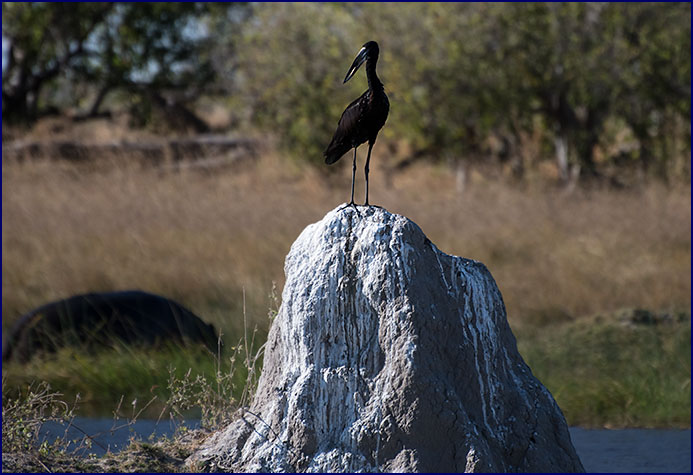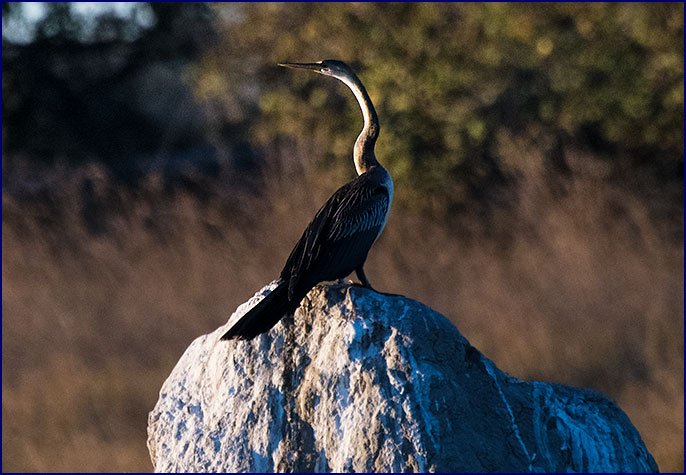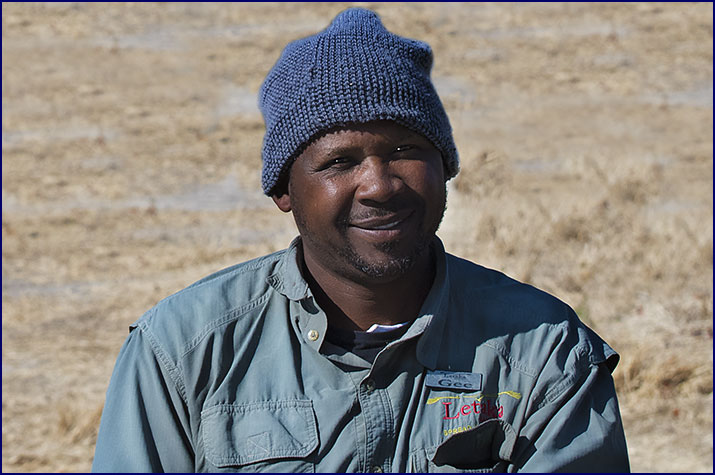|
July 29 continued
We
went back out around three o'clock, driving behind the camp past
impala and zebras. A fish eagle, a yellow-billed stork and a grey
heron flew over us, one after the other. We headed out to the
lechwe floodplain. A large croc that was basking on the shore
slipped into the water ahead of us. A superb lechwe buck stood
sentinel in the ankle-deep water, backlit, a dark silhouette
against the sparkling floodwaters. The rest of his herd grazed on
drier ground across the floodplain.
We drove along a canal
with more hippos; they really are amazingly round and fat. We got
a good close look at
one out of the water as he ambled along grazing, paying us no
attention whatsoever. An open-billed stork stood on a termite
mound, one of the best looks we had gotten at this interesting
tall black bird.
|

Open-billed
stork |
We met up with another guide who had been
looking for lions for his clients all week; he couldn’t believe
we had spent all morning with 26 of them. Gee led him to the
pride. The mother and her four young cubs were very near where we
had left them in the morning; the mother was sleeping flat out and
the babies resting quietly, several of them peering up at us
curiously.
The big male was resting in the
shade; he raised his head and looked around, gazing at us
assessingly. After a while he got up, yawned and stretched, and
apparently deciding we were not a threat, walked to a different
spot and lay down again. Even resting quietly he had a presence
about him, a sort of savage splendor. It was clear he had an
innate awareness of his own supreme maleness. There was no doubt;
we were in the presence of royalty.
We came to the mounds
where we had left the hunting pride in the morning, and most of
them were still there sleeping, some in the shade and some in full
sun. One lioness was lying almost hidden in a bed she had made
herself in the tall red grass. An older lioness who appeared to be
the dominant female was basking in the sun; she yawned
expansively, showing imposing fangs, and then groomed herself. She
snoozed a little more, and then made a production of ecstatically
scratching her neck and chin with her hind foot. A half-grown cub
lay nearby, watching her. The male with the battle scars was still
sleeping in the same place we had left him. He reminded me of my
house cats; I will leave them sleeping on my bed in the morning,
and when I come back in the room 12 hours later they are still in
exactly the same position.
The dominant lioness yawned some more, and then stood up and
walked over to the male. She rubbed faces with him in greeting,
and then sat down beside him and started to lick him submissively.
He was not terribly nice to her, and she bared her teeth in
return. Then he did a bit of yawning himself; when he stretched
his jaws wide it looked like he was letting out a roar. He looked
cross; the wounds on his head most have been sore – or maybe he
was just hungry? The males had likely not been around to share in
that last kill.
Imminent action seeming unlikely, we left the lions for the moment
and drove around the area. We saw tons of waterfowl, several
crocodiles, a bull elephant, and a pair of ostriches. You can’t
help but laugh, watching the male ostrich prancing around like a
prima donna. A giraffe was drinking at a channel, the water
streaming from his mouth as he lifted his head. A lechwe bull ran
through the water, the sun behind him turning the spray to
glittering diamonds.
We encountered a herd of
elephants in a patch of forest; they seemed unaccountably nervous
as they moved through the trees. They trumpeted in alarm when they
saw us, then reversed direction and quickly moved out of the area.
At the time we weren't sure why they were so wary; it wasn’t
until I looked at my photos later that I realized they had a very
small baby with them. Even in the pictures I could barely see him;
the whole herd works together to shield the smaller babies from
view.
A red-eyed dove sat on a
twig, dressed in shades of brown, slate grey and rose, with a
black ring around her neck. These lovely birds look much like the
more common cape turtle-dove, but the red eyes set them apart. A
darter stood atop the same termite hill we had seen the
open-billed stork on earlier in the day. A grey go-away bird
peered at us, and a Senegal coucal perched in a thornbush. We
passed Pelican Pond again, it was still empty. I asked Gee how
often he saw a display of birds like we had seen there the
previous day; he said it was very rare.
|

African darter |
We stopped back by the
lions again; they were all starting to sit up and yawn now; it was
evident they would be heading out to hunt again soon. Two powerful
lionesses snuggled together, grooming each other in mutual
respect. We watched the sun go down, turning the sky to fiery
colors. The pride started to move about, but we had lost the light
and had to head back to camp. We saw a hyena snuffling about in
the dim light, sca-VENGing,
no doubt. We returned to camp while admiring the post-sunset glow
over the watery plain.
We heard the lions calling as we sat around the campfire,
and we were sad that this was our last evening to be doing so. But
oh, what a day it had been! We
certainly needn’t have worried it might be a dud. For once there
was no disagreement about the highlight of the day; watching two
honey badgers back down a pride of lions was everybody’s choice.
July
30
The lions were calling again in
the night, and early in the morning, very loud and near. The
hippos kept up a hearty chorus of honking laughter. It was leaving
day, and we were very sad for the mobile camping safari portion of
our trip to be coming to an end. After our last breakfast of
jungle oats and toast, we set off in the Landcruiser for Maun. We
would have loved to have gone and found those lions again, but of
course we couldn’t.
It was a beautiful morning. The
sky was accented with clouds edged in fiery light, and geese flew
across the sunrise. As we headed toward Maun, it seemed like the
animals all came out to say goodbye.
A gorgeous giraffe stood by the side of the road, posing
for us in the spectacular morning light. Soon she was joined by
another, and they gazed at us with gentle expressions. A large
flock of pelicans gathered around a small waterhole, no doubt some
of the same ones we had seen at Pelican Pond. A bit further on a
family of zebras greeted us, including a wide-eyed foal that still
had his long baby fur.
Three magnificent kudu bulls walked beside the road, and
then one at a time they crossed in front of us in a stately
manner. Soon they were followed by two more; they briefly picked
up a canter before stopping to turn and pay their respects. Impala
and warthogs put in an appearance, as did hornbills, doves,
Guineafowl and a bateleur eagle. An elephant paused to bid us
farewell as he crossed the road ahead of us.
We came to the veterinary checkpoint at the gate out of
Moremi, where we were required to walk through a footbath of
disinfectant to avoid the spread of foot-and-mouth disease. We
could see the controversial Buffalo Fence, a double line of high
wire fencing that was erected to prevent the spread of disease
from cattle mingling with the wild buffalo. Gee told us that
millions of wildebeest and zebra died on that fence because they
could not follow their migratory routes to get to water.
Elephants, on the other hand, just push the fence down. The
buffalo have learned to follow the elephants, and cross the fence
once it is down.
We were now out of the park and on the main road to Maun.
Gee told us some facts and stories to pass the time. He said that
leopards are more aggressive than lions. If confronted by one, you
should stare a lion in the eyes, but avoid eye contact with a
leopard because it might provoke an attack. He told the story
about when he and his dad once stared down a lion for over four
hours when he was a small child. The lion was right in front of
them, threatening, but as long as they kept eye contact with him,
he would not attack. Gee and his father stood for four hours
staring into the lion’s eyes. However as it started getting
dark, Gee’s father knew that as soon as the lion could not see
their eyes any more it would attack and kill them. Eventually he
raised his gun and shot the lion, which he had been hoping to
avoid. Gee said in such a case you just get one shot – you
better not miss!
We pulled off the road and stopped for tea break down by a
wide river. A donkey stood out in the water; at first I thought it
was a hippo. There was a fence along the river consisting of just
a single strand of wire, which would keep out nothing – as
evidenced by the donkey. There was a big palm tree nearby, which
we used when we needed to go check the tires. It was not very
private, but nobody appeared to look or care. Ladies were doing
their laundry in the edge of the water, hanging it on some upright
posts to dry. I wondered if there were crocodiles.
Several times local people came down the path to get water,
filling their buckets and carrying them back up the hill on their
heads. One woman had several small children with her; they seemed
scared and started to cry. Gee told us they are afraid of white
people. We gave the kids some Werthers candies, after which they
seemed less afraid. We gave one to their mother too; she seemed
surprised and appreciative. I felt a bit awkward, hoping we were
not being stereotypical ‘Ugly Americans.’
These people are lovely, so down to earth and true, and
their lifestyle is a million miles from ours.
It was interesting to pass through the small towns and
communities. Before long we came to Gee’s village, Shorobe. He
said it was an hour’s walk from his island, Chinxom Island. We
passed the school he went to, and the house his mean aunt lived
in, where he stayed when he was in school.
After a while the road turned to pavement. We started
seeing more and more donkeys and cattle by the road, either
grazing on the verge or laying down resting. Two donkeys without
bridles were pulling a cart. A bit further on there was a pair of
donkeys tethered together with ropes around their necks, and
hobbled with a bandana. As we got closer to Maun, there were
cattle and goats in the road everywhere. Gee said the cattle and
goats are put in kraals at night to protect them, but the donkeys
usually are not. The cattle are branded for identification.
We saw several horses standing chest deep in the Delta
waters eating grass, and then others just loose along the road.
Horses roam free also, like the donkeys. There were small stacks
of firewood for sale along the road; the local people sell it to
the self-driving tourists.
Gee pointed out a river that leads
to his property, which is on an island with palm trees, between
two rivers. One can
only get to it by mokoro or boat. He plans to build a lodge or
camp there in the future. He told us he has seven cows on the
island. He did also have 14 goats, but they went off in the rainy
season and got eaten.
We said farewell to Gee at the airport in Maun. We were
very sad to leave him. It had been a charmed trip, extraordinary
in every way. I was already making plans for when I could come
back.
|

Gee
|
We also said goodbye to Patty and Rob, who were going home.
The rest of us, Paula, Natalie, Tara, Jineen and I, were heading
on to Camp Kalahari at the Makgadikgadi Pans for the final add-on
portion of our trip.
|